FAQ
HYPACKに関する質問
16.データ処理(Data Processing)
ID.*Q16-9M
Q. シングルビームエディターにおけるビームステアリング(Beam Steering in the Single Beam Editor)[英語]
A.
The beam steering option in the single beam editor controls the depth and location of Hypack® soundings. The default setting is off (do not steer the beam), which is correct for most installations. There are certain circumstances where beam steering is desirable, which of course is why we put it in the program.
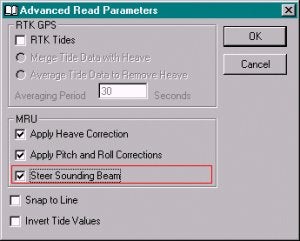
What is beam steering? It is the aiming of the sounding beam in the direction given by the pitch and roll sensor. Just like a flashlight. If you do not have a pitch and roll sensor, obviously you do not want beam steering. If you have a wide angle transducer, you still do not want beam steering (for less obvious reasons described below). If you have a narrow beam transducer, a pitch / roll sensor and you work in rough water, you may want to steer the beam.
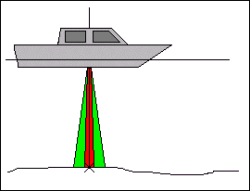
First, we look at a sounding taken in calm water over a relatively flat bottom. Narrow beam or wide beam, beam steering or not, sounding depth and location will be the same and correct.
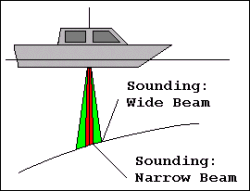
Next we look at a sounding taken in calm water on a steep slope. The echosounder returns a depth corresponding to the first return, which in this case is not directly under the transducer. Note that the error increases with beam width, which is a good argument for using a narrow beam transducer.
(Methods exist to "migrate" the sounding to it's proper depth and location but to my knowledge, no one uses them.)
In the two examples above, beam steering has not been an issue because the beam is close to vertical. Now we examine a few cases where the beam is not vertical, i.e., pitch and roll angles are involved.
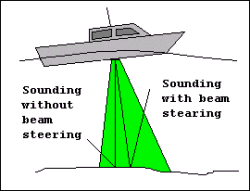
The first diagram to the left shows the case of the wide beam transducer. The depth returned from the echosounder is the true depth directly beneath the transducer. It will be recorded properly by Hypack® when beam steering is off. If beam steering is on, it will be recorded forward and slightly shallower than actual. Moral is: don't use beam steering with wide angle transducers.
The final example shows a narrow beam pitched forward. The actual sounding point is the closest bottom point within the cone of sound. Note that the sounding point calculated without beam steering is slightly off as is the sounding point calculated with beam steering!
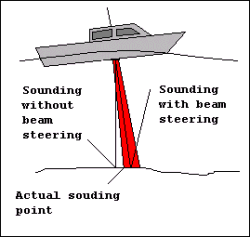
This is getting complicated, but at least one thing is clear: when the combined pitch and roll angle is less than the beam width, do not use beam steering. I think this covers all protected water surveys, regardless of beam width. For open water surveys, consider beam steering when the boat attitude angle is much greater than the beam width. If the boat is rolling +/- 10 degrees with a 3 degree transducer, definitely consider beam steering.